While potatoes are inexpensive to buy, there’s nothing quite as delicious as homegrown potatoes. I LOVE unearthing some and cooking them right away. My favorite new potatoes are fried, or steamed together with fresh peas: YUM! If you’d like to learn how to grow potatoes, you’re in the right place.
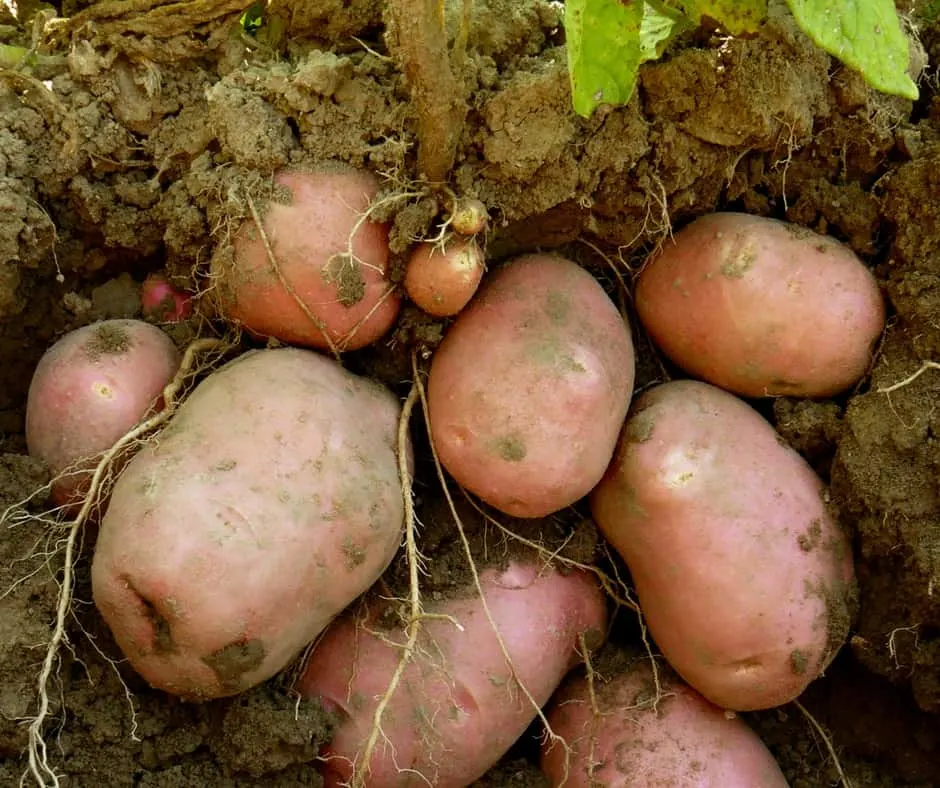
The Best Soil For Growing Potatoes
To grow a successful crop of potatoes, you need to have good, rich soil, as this is a hungry crop. With the right food, plenty of water, and feed during the growing season, you should get a healthy crop of potatoes.
Here’s how to prepare the soil for growing potatoes: in the fall, work on the land by digging or rototilling and incorporating plenty of well-rotted manure. This will also help to prepare the soil for other root vegetables as well.
You should add the well-rotted manure either in the fall preceding the next year’s crop or in the spring just before planting. The advantage of adding manure in the fall is that worms will have a chance to draw the manure lower into the soil. Then, double-dig the manure in, and your soil will be in perfect condition for potatoes.
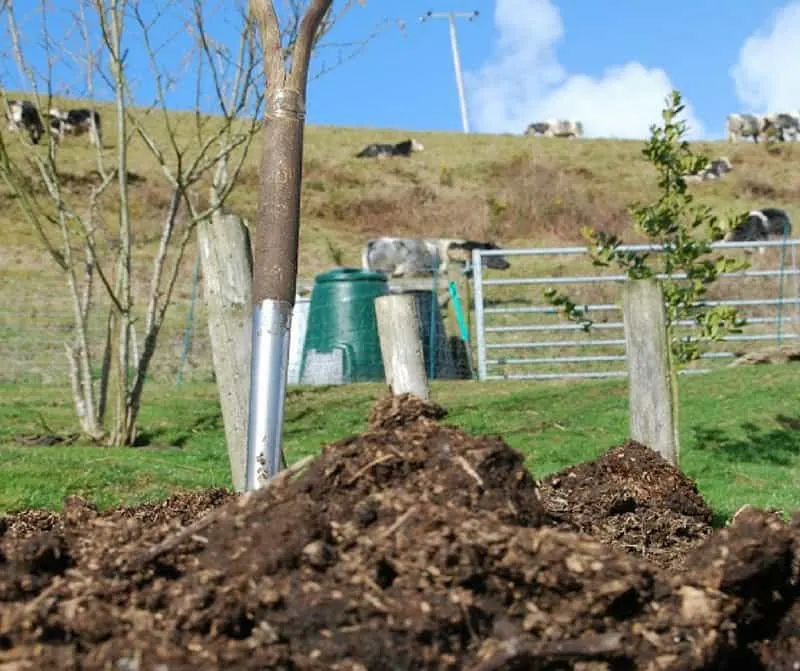
Even with this heavy feeding, you should also add garden compost or leaf mold in the spring, so that the soil will retain more water and help with the development of your potatoes.
You can plant your potatoes in trenches and as an additional fertilizer dress the trench with Fish, Blood, and Bone food and line the trench with seaweed. The reason to use seaweed is that it is high in nutrients and the salt content helps to deter slugs.
Of course, seaweed is not practical for everyone, so as an alternative if your comfrey has started to grow, layer the trench with the first cut, you could also use nettles or a pelleted fertilizer.
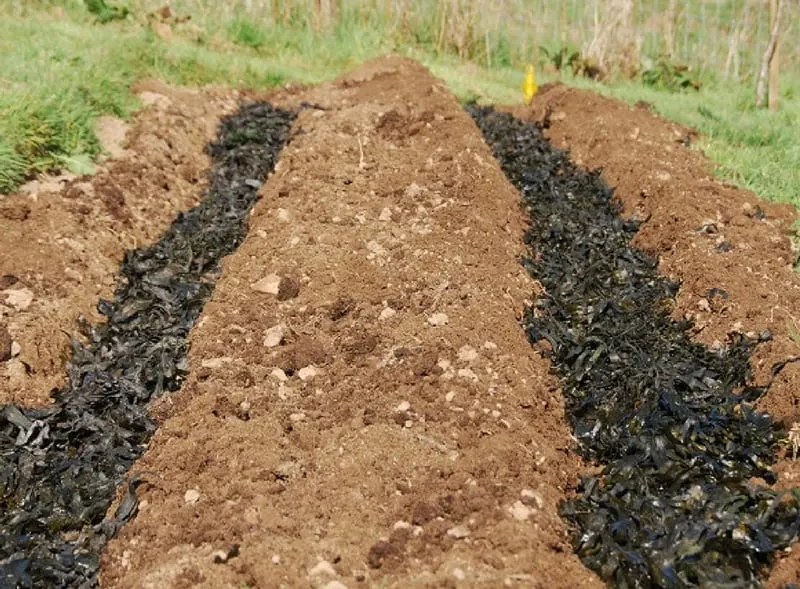
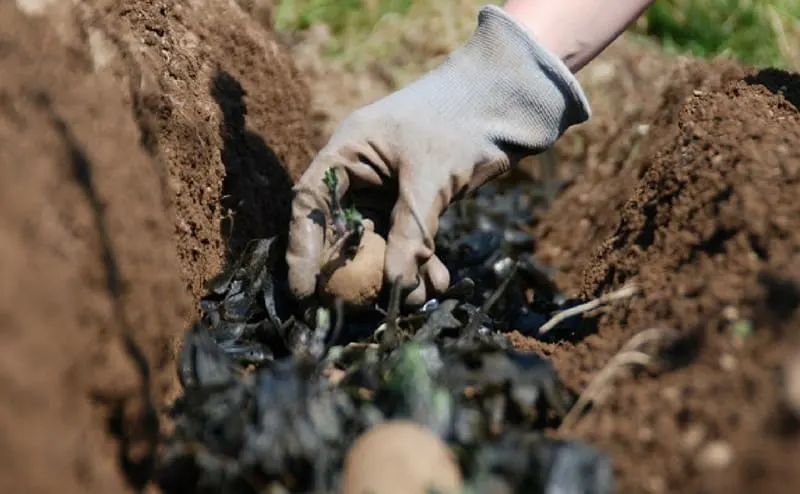
Potatoes need a lot of nutrition, and the more you feed and work the soil, the more the crop will reward you. In fact, the potato patch should be the most heavily fed part of the garden. In general, you can add one wheelbarrow of manure per square yard of potato bed.
Related: How to grow potatoes in containers.
How To Grow Potatoes
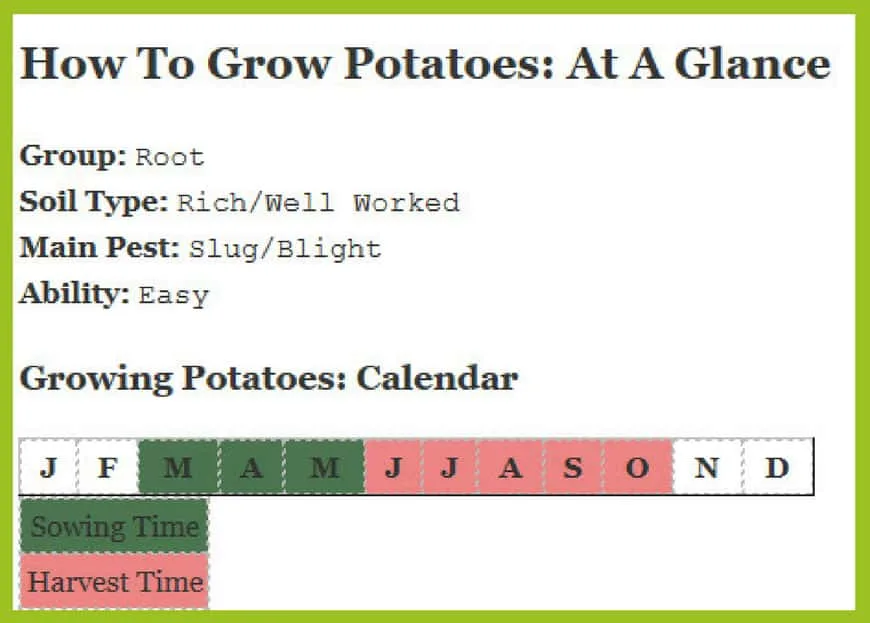
Start by choosing your variety of potatoes. Supermarket potatoes are NOT the right potatoes, no matter how much you might like them.
You can choose from hundreds of varieties, as well as names such as first early, second early, and main crop.
How to choose which potato variety to grow
So let’s begin by clearing up what these phrases mean.
First early potatoes
The first early potatoes are smaller potatoes and will usually be the first to be harvested. The Jersey Royal Potato is the classic first early. However, you cannot grow Jersey Royals unless you are in Jersey, so if this is a variety you enjoy choose the International Kidney variety.
Although the term first early tends to lead you to believe that this is an early potato, this is not strictly the case. It would be more accurate to state that the first early potato is the quickest to grow, usually taking ten weeks from sowing to harvest.
Some favorite first earlies are:
- Swift
- Arran Pilot
- Rocket
- International Kidney
- Pentland Javelin
Second early potatoes
The second early potatoes are the next crop to be harvested, assuming you planted your potatoes at the same time. They take another three weeks to mature, normally being ready at 13 weeks.
The second earlies are still small potatoes, although they are usually a little bigger than the first croppers and make perfect salad potatoes.
Some favorite second earlies are:
- Charlotte
- International Kidney
- Nadine
- and the absolutely stunning potato, Anya
Maincrop potatoes
The main crop potatoes are, as the name would suggest, the largest and most versatile main crop of potatoes.
The maincrop will usually provide the larger storing potatoes and make perfect baking, mashing, roasting, and french fry potatoes, taking 20 weeks to mature.
Some usual maincrops would be Maris Piper and King Edwards, although a favorite that breaks the rule is the Pink Fur Apple potato, a very old salad variety. And for something a bit different why not try the Salad Blue, which is neither a blue or salad potato, more accurately described as a traditional floury main crop potato, tinged with purple.
When you are choosing your potato varieties, do so early in the year as by at least mid-February you will need to have your potatoes chitting.
What is potato chitting?
Chitting is not complicated, but it is important so that you give you’re a good start before sowing.
Quite simply, chitting is just laying out your seed potatoes in a tray with the side with the most eyes facing up, and leaving them in a cool, light, frost-free room so that they start to shoot. Chitting is really giving your potatoes a head start so that they establish and crop earlier.
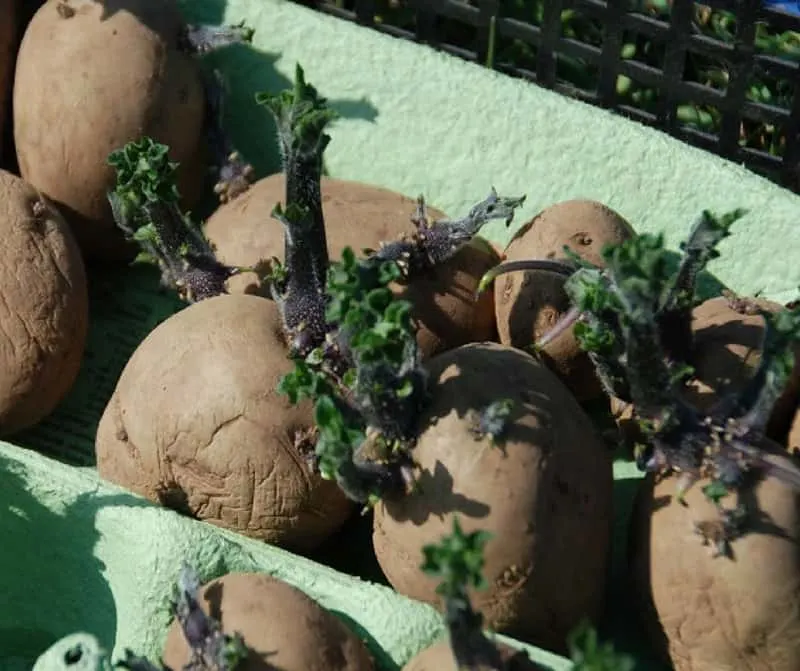
Where to get potato seeds
Have you ever had potatoes in your garage starting to sprout? Of course, you did: I did too! You might be tempted to think you can use these to grow some potatoes, but it’s not advisable. Potatoes are grown in specific conditions, to prevent viruses.
Certified seed potatoes are tested to make sure they don’t have any viruses to pass on, which will make sure that your garden doesn’t become a breeding ground.
This is why it’s advised not to use regular store-bought potatoes as a seed – they aren’t certified free of viruses. Don’t try and cheap out – buy certified seed potatoes from a safe source.
How To Prepare Potatoes For Planting
Lay your seed potatoes in potato chitting trays (you can also use egg boxes) and put them in a lean-to shed or other frost-free place, which has plenty of light.
When it is time to sow the seeds you will place them in a trench with the shoots facing upwards – if you would like larger potatoes in your main crop varieties you could break off all but one or two shoots before planting.
When to plant potatoes
Traditionally potatoes are sown at Easter, which has more to do with the workers’ holiday rather than being a rule of thumb, but Easter does make a good reminder to get ready for planting your spuds.
As Easter is a movable feast falling between the 22nd of March and the 25th of April, it is probably safe to say that potatoes can be planted from the last week of March onward and can be sown right through the spring and early summer.
The rule on how late they can be planted depends on the first frost of the autumn, and which type of potato you are growing. Maincrop can go in as late as the end of May and first earlies by the end of July, and both plantings should give you a crop of potatoes for mid-October.
How to plant potatoes
So on to planting your potatoes; plant potato seeds in a trench at a depth of about 3 inches for small potatoes and 5 inches for larger maincrop.
Sprinkle some blood and bone fertilizer at the bottom and sides of the trench, layer with seaweed or comfrey, and plant the seeds with the chitted shoots facing up. Space first and second earlies 10 inches apart with 15 inches between rows, and maincrop use a 15-inch space and 30 inches between rows.
If seaweed or comfrey is not available to use as manure, garden compost, pelleted fertilizer or municipal compost.
Then cover the trench, drawing the soil up to a peak.
For the first month, when the risk of frost is more threatening, as the green plant shoots start to break the soil, draw up more soil to cover and protect them. The soil covering will also protect the tubers from light, which turns them green. Continue to cover if you see any potatoes forming at the surface.
The first and second earlies will not need extra feed, just a watering if dry, and a watchful eye on weeds. Maincrops however will definitely reward you for some extra nutrients which could come in the way of a liquid comfrey tea, a mulch of comfrey or nettles, or a commercial liquid fertilizer.
Can you plant potatoes in containers?
Absolutely! Before we moved to our current property, all we had were 3 small garden beds, and we weren’t about to use those for potatoes. But we used a large plastic bucket and several smaller 5 gallon buckets to grow potatoes, and we had lots of delicious potato tubers to enjoy.
If you want to grow potatoes in containers, make sure to make holes at the bottom of your containers, to facilitate water drainage, as you want to keep the soil moist, but not water-logged. That’s all there is to it: really!
Here are out potatoes growing in containers along the side of the house.
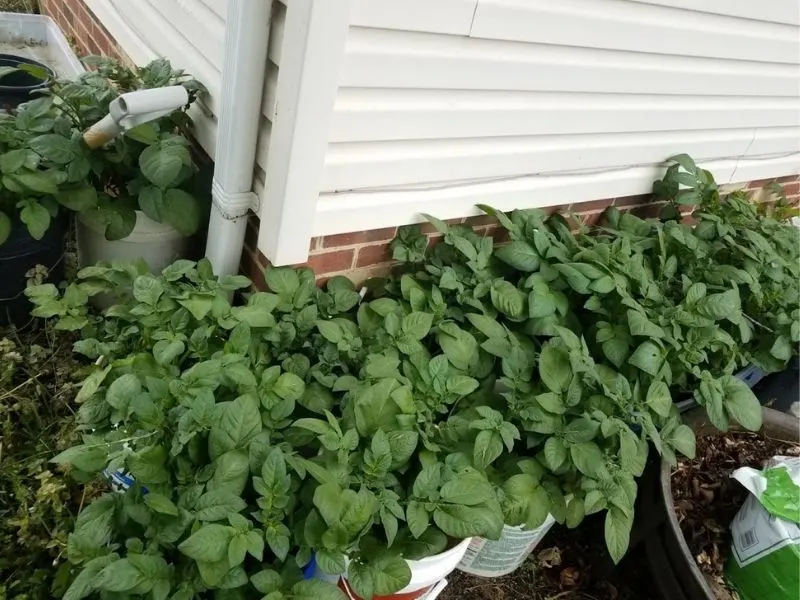
Potato Pests And Diseases
Potatoes are susceptible to several sorts of pests and diseases, some of which are more common than others. Other than the onslaught of slugs, if this is your first time planting potatoes most of the issues are only recognizable at the time of harvest when, unfortunately, the damage is already done.
Not that this should dishearten you, as most of the diseases you could possibly encounter can be overcome by selecting varieties that have a bred resistance to the problem your garden soil is harboring.
Here is a potato pest and disease list to help you identify and cure any problems you encounter.
Potato Slugs
Garden Safe Slug & Snail Bait (HG-4536) (2 lb) Slugs probably cause the most damage to potatoes, so whatever you do to control slugs, triple your efforts around potatoes.
Slugs probably cause the most damage to potatoes, so whatever you do to control slugs, triple your efforts around potatoes.
One of the advantages of lining the planting trench with seaweed is that the salt helps to keep the slugs off, although the effect will not last for the whole growing season of the main crops.
We don’t like to use slug pellets unless we can keep wildlife off, so it tends to be beer traps or dawn and dusk slug hunts. Nematodes are another possibility, these are slug parasites that you water in, and they do fit into an organic system.
Barriers such as sand, coffee grinds, and eggshell can help to keep slugs from entering the potato patch but will do little to protect your potatoes from the slugs already present.
Take a look at the pest and problem page for more ideas.
Potato beetles
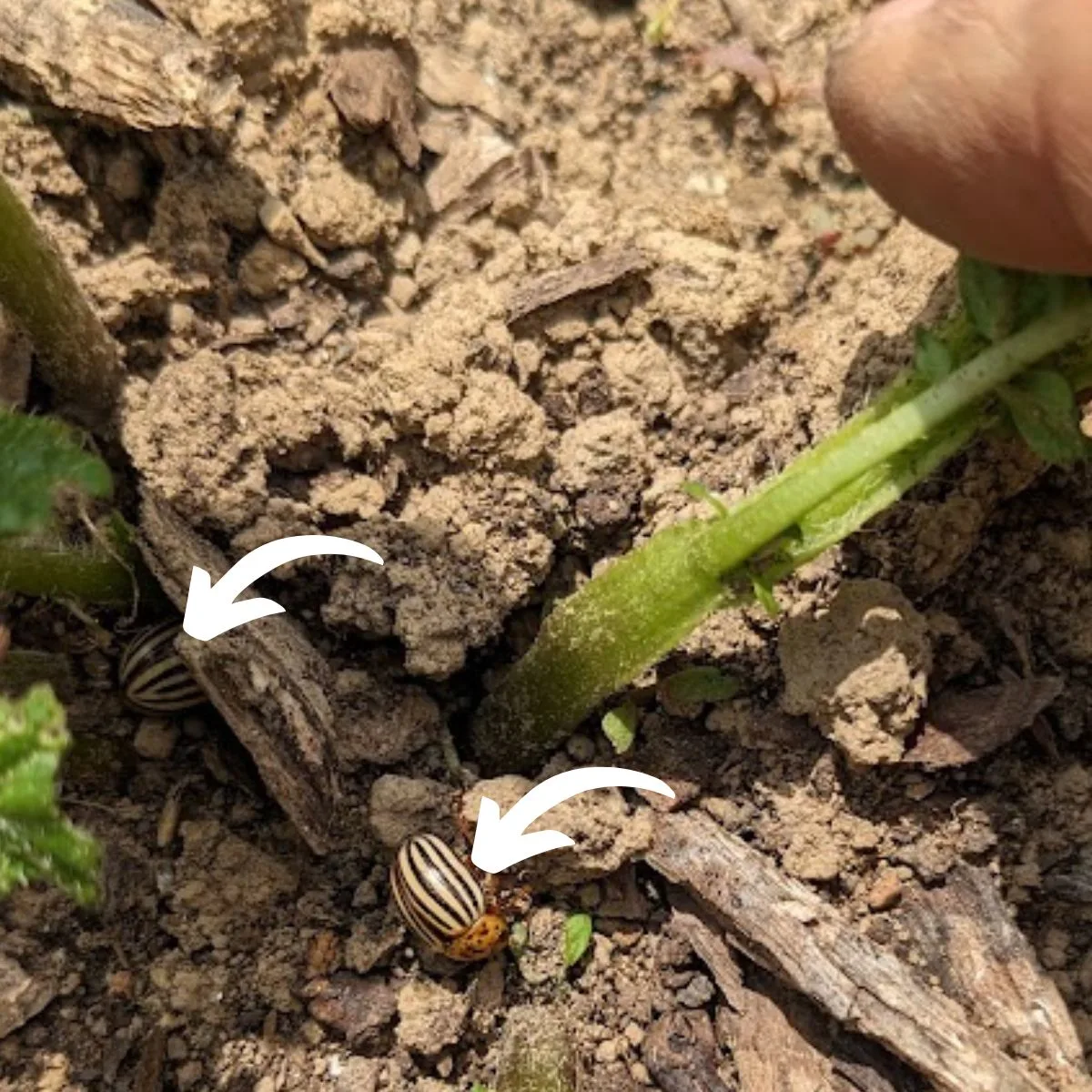
Potato beetles, also known as Colorado beetles (Leptinotarsa decemlineata), are a common pest that attacks potato plants and other plants in the nightshade family, such as eggplants, tomatoes, and peppers.
They are about 10mm in length and have a distinctive yellow and black striped pattern on their wing covers. Adult beetles emerge from the soil in early spring and lay their eggs on the underside of potato plant leaves. The larvae that hatch from these eggs feed on the leaves and can quickly defoliate an entire plant if left unchecked.
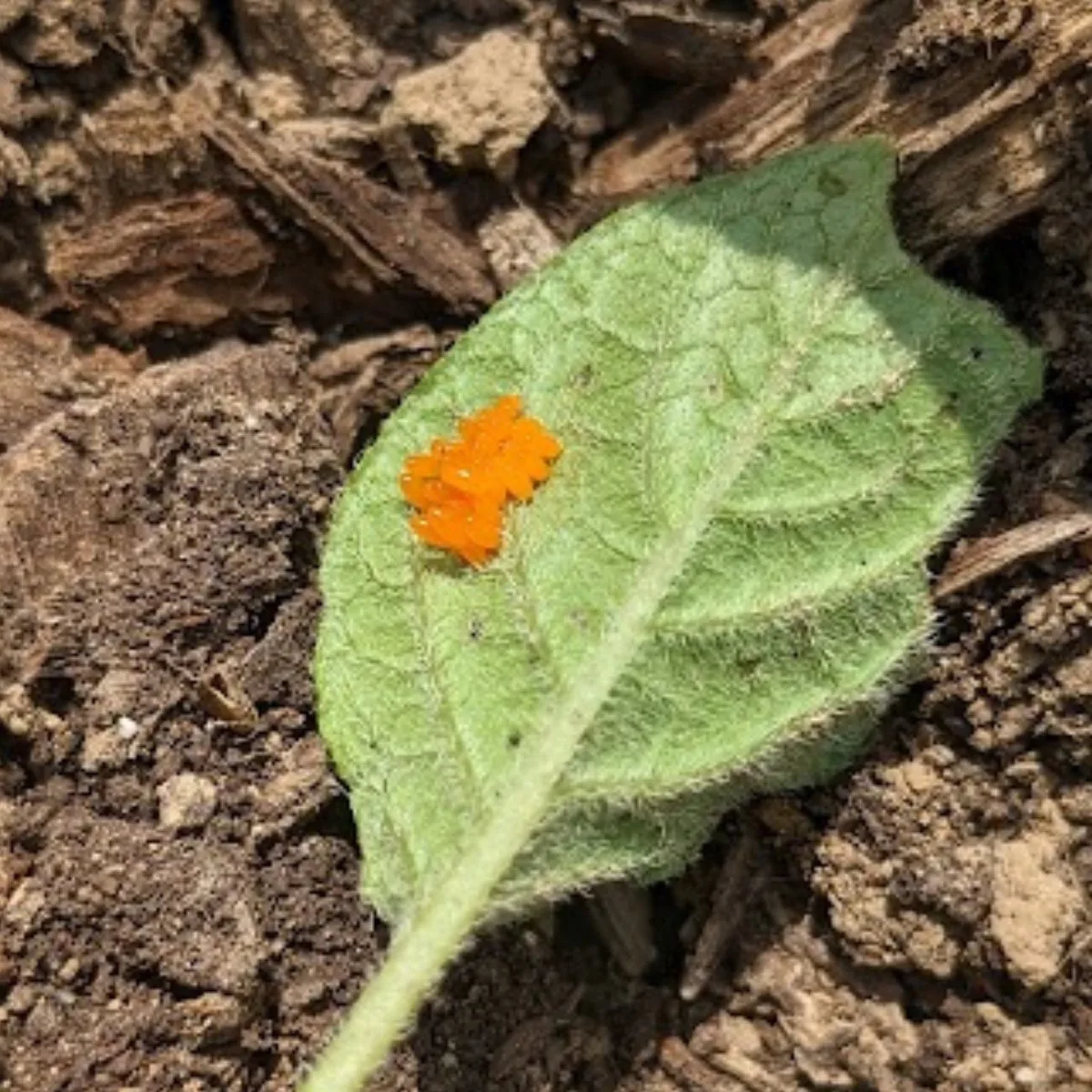
If you’re growing a few rows of potatoes in your home garden, the best way to get rid of them is to physically remove the beetles by handpicking them off the plants and dropping them into a bucket of soapy water. This method can be effective for small-scale infestations, but it can be time-consuming for larger gardens.
I check on the potato plants as soon as the leaves emerge from the ground. I go twice a day with a little container of soapy water and drop the beetles in there. I also check the underside of the leaves for eggs (they are a bright orange color, and very easy to see). And whenever I find a cluster of eggs, I remove that leaf and drop it into the soapy water too.
This way, I reduce the number of beetles I have to deal with later in the season.
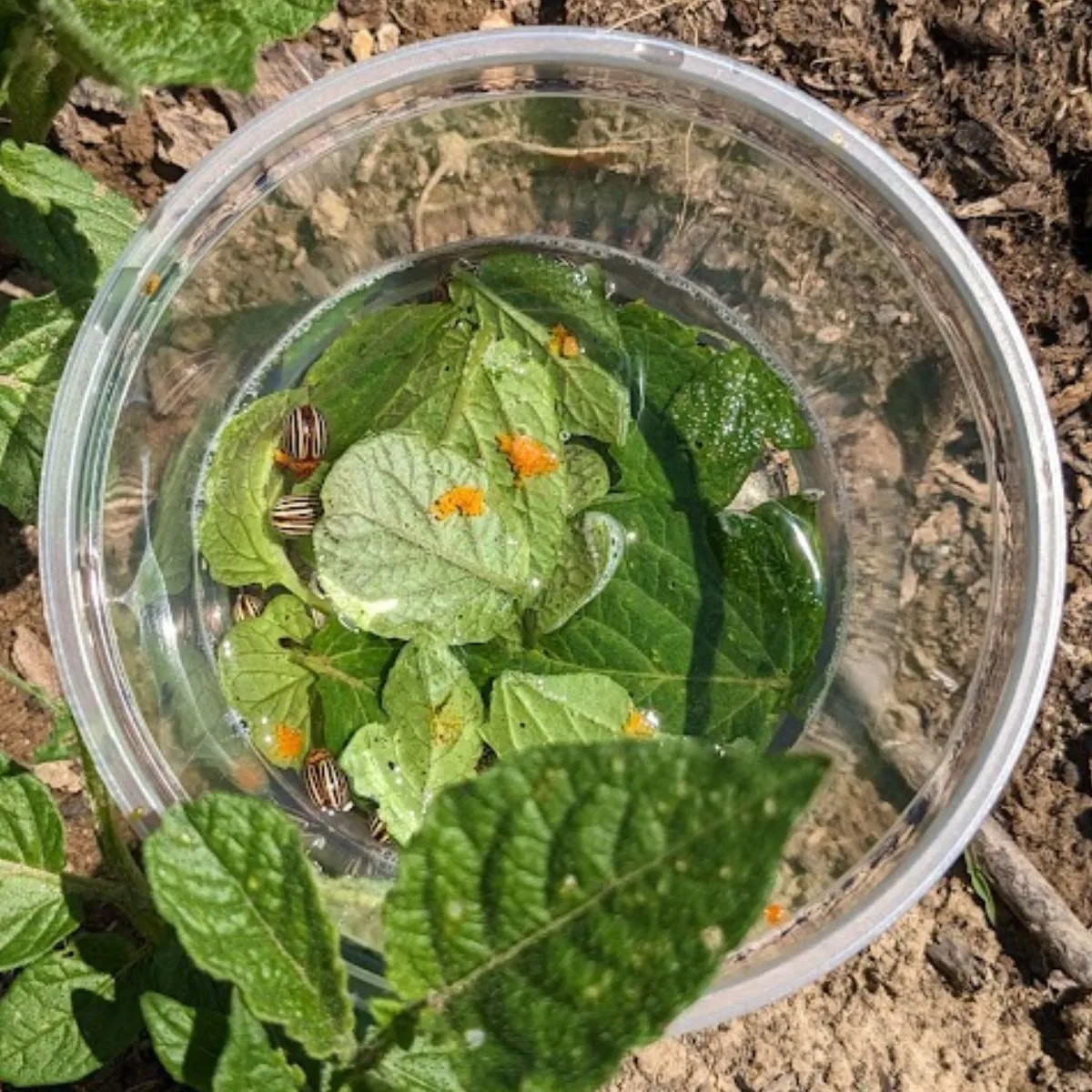
Crop rotation can also be an effective strategy for controlling potato beetles. By planting potatoes in a different location each year, the beetles will have a harder time finding and attacking the plants.
Potato blight
Blight is an airborne fungal disease that causes the leaves of potatoes to wither to wet rot, turn brown and die. It is more likely that you’ll see an infection of blight if the weather is wet and humid. Fortunately, only the main crop varieties are vulnerable.
If you get an attack of blight you will at first see the evidence on leaves, once about a quarter of the leaves carry the infection, or if you notice browning of the stems, you will need to cut off the haulm, or foliage, of the plant and dispose of it. Then two weeks later, harvest the potatoes.
To avoid blight, always keep to the spacing recommended by the potato seed producer. There should be plenty of airflow between the leaves so that they can dry more quickly. Rotate your crops and use certified seed producers to guarantee that you are not introducing blight spores to your area.
If blight is a problem there are blight-resistant varieties available, such as Sarpo Axona, Sarpo Mira, Cara, Kondor, Pentland Dell, and Pentland Squire.
Potato Scab
A brown rising of the potato skin, which looks unsightly, but has no real detrimental effect on the potato itself, as long as it is peeled.
Scab is caused by an irregularity of water early in the growing season and can be avoided by mixing plenty of compost or leaf mold into the soil to help it retain water. Of course, water is needed in dry spells.
If you have a problem with potato scab you can grow scab-resistant varieties such as King Edward, Nicola, Accent, Casablanca, Maris Bard, Nadine, and Arran Pilot.
Other Pests & Diseases of Potatoes
Potatoes are susceptible to many other problems. This is why growing potatoes come with a range of rules that many gardeners will tell you to follow.
This list includes:
- Blackleg
- Wart
- Potato Cyst Eel Worm
- Wire Worm
Although these are all quite rare, that’s quite a collection of problems.
When Do You Harvest Potatoes
The time to harvest potatoes depends on your situation. For example, I harvest potatoes throughout the summer, because I LOVE new potatoes, and enjoy cooking freshly harvested potatoes.
But if you want to harvest for winter, let the potatoes in the ground until just before the first frost, and the leaves have dried up. This gives the spuds a chance to get all the nutrients they can while keeping them safe in the ground.
How To Harvest Potatoes
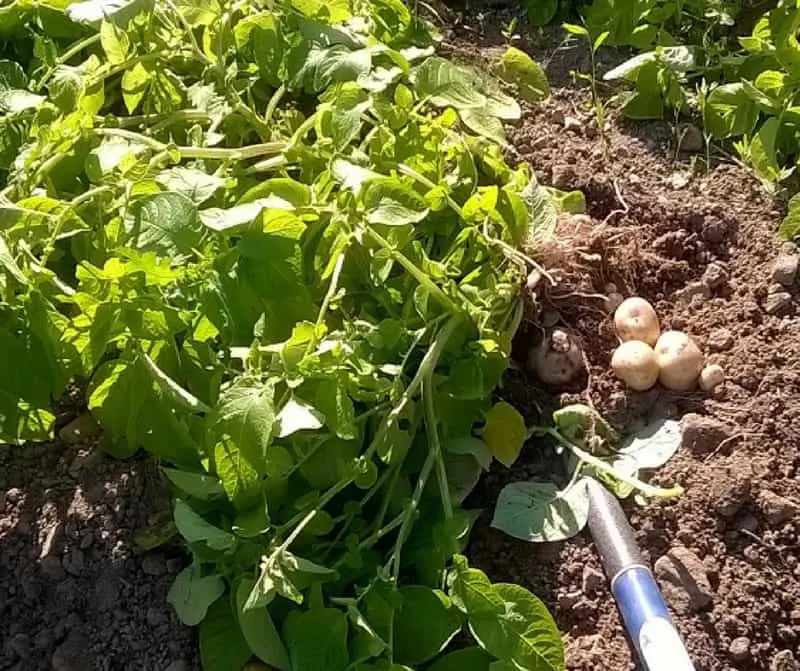
Harvesting your potatoes couldn’t be easier. When the time has come to bring your potatoes in, lay a burlap sack, fleece, or an old blanket on the ground and use a gardening fork to uncover your potatoes. Drive the fork down at the base of the drawn-up soil, gently leave it under the potato mound, and lift. Turning the soil this way will reveal a mass of round nuggets.
There is nothing that is quite as satisfying as enjoying the results of hard work!
Once you have turned the spuds, pick them out and place them on the blanket to allow them to dry and their skins to harden.
After about an hour sort through the potatoes putting perfect samples into a dark paper or burlap sack. Keep the damaged ones to be used right away.
It may also be worth tossing in a scattering of slug pellets, just in case the odd slug made it past your scrutiny. And after a few weeks, recheck the bags just in case any potatoes are getting soft.
Learn more about how to properly store potatoes.
So now you know how to grow your own potatoes. Enjoy the experience!
Learn more about planning your vegetable garden.
How To Cook Potatoes
A list of recipes for potatoes could quickly turn into a book, such is the versatility of the humble potato. But you may want a few ideas to use a glut of potatoes, especially if you have had a lot of damage from your harvest.
Here are a few potato dishes that use up a large number of potatoes in one go:
- Cheese & Potato Pie
- Potato & Leek Soup
- Celeriac & Potato Gratin
- Leek & Potato Pie
- Potato Rosti
- Potato Curry
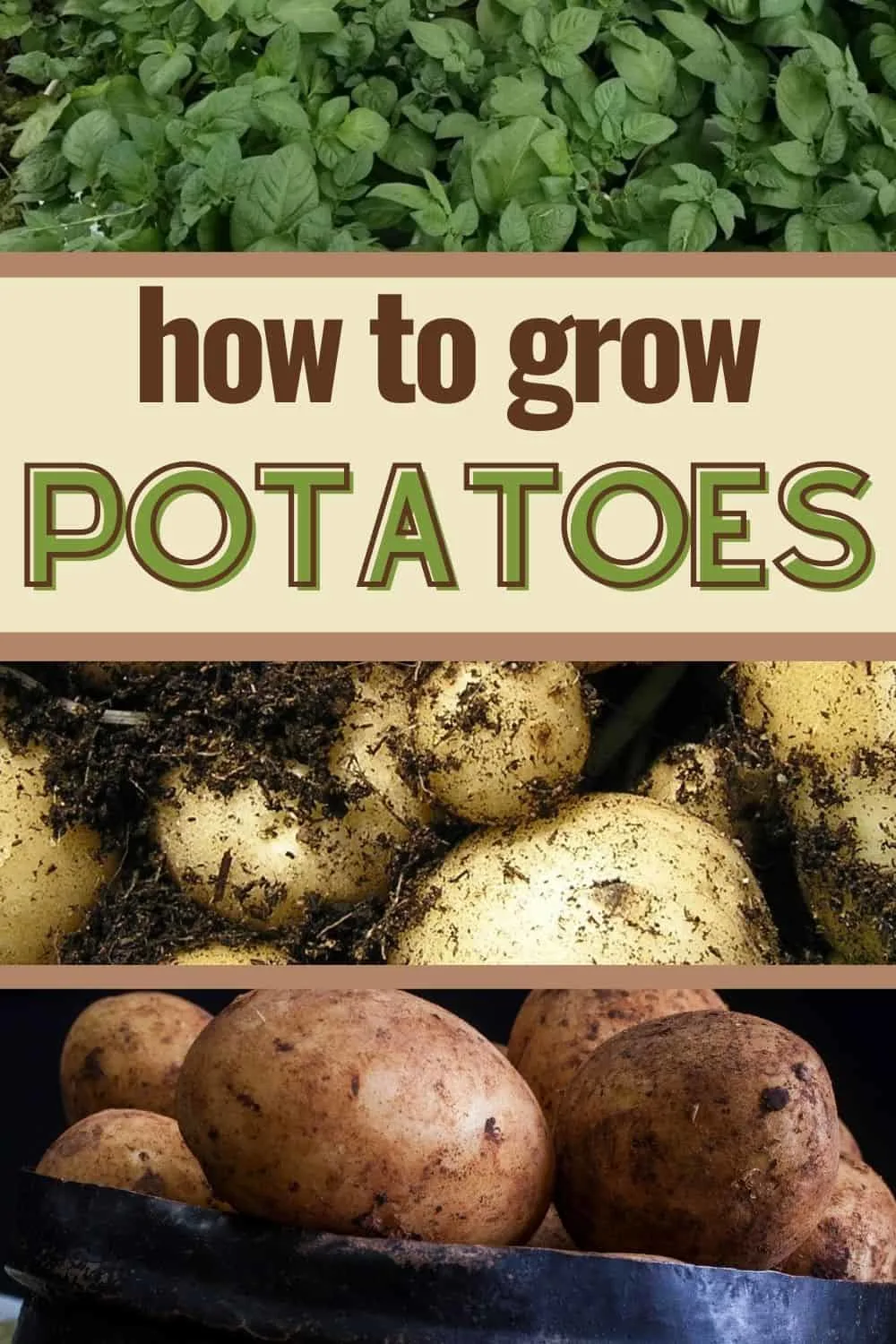
Adriana Copaceanu is a passionate nature lover living in the country on her dream property where she grows vegetables, lavender, and wildflowers that she shares with the wildlife they attract. When she's not in the garden, she loves spending time with her chickens and planning her next nature project. Check out her books below:
How to Grow Lavender for Fun and Profit: Lessons Learned from Planting Three Hundred Lavender Plants

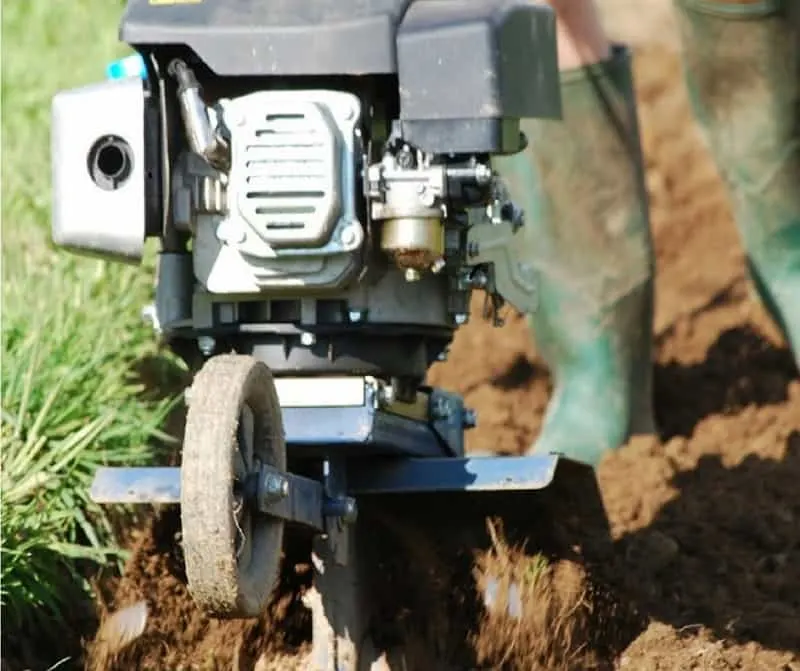

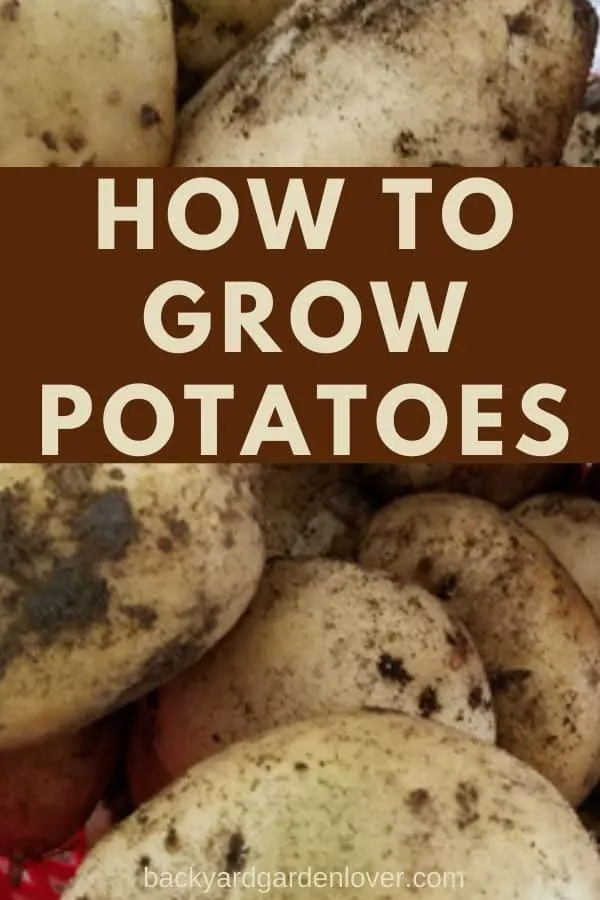
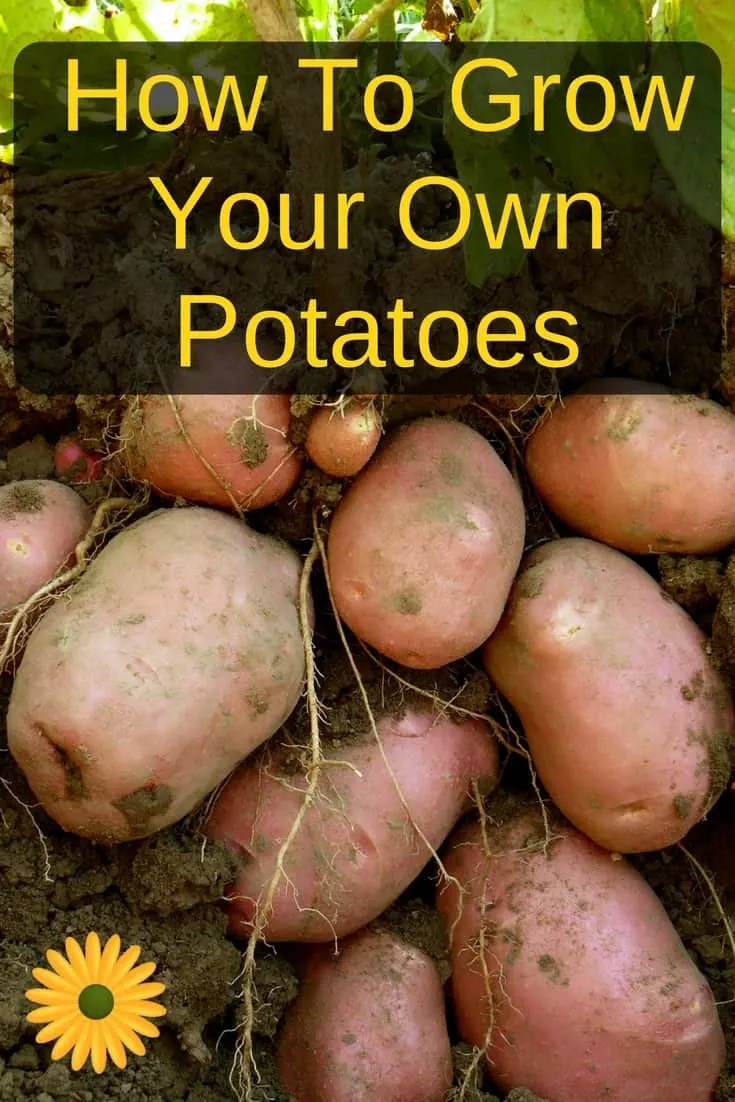
How To Grow Bell Peppers For Delicious Summer Flavor
Monday 28th of November 2022
[…] how to grow potatoes […]
Root Vegetables List: 15 Favorites With Pictures
Tuesday 25th of October 2022
[…] Dig little trenches and plant potato segments “eyes” up in hilled rows. Cover with a few inches of well-drained, acidic soil. Plant them where they’ll get full sun. Here’s all you need to know about growing potatoes. […]
9 Best Companion Plants For Cauliflower (And 3 To Avoid)
Wednesday 1st of June 2022
[…] Learn more about growing potatoes. […]
The Complete Guide To Cold Frame Gardening
Sunday 4th of April 2021
[…] like snow peas and potatoes will be ready very early, and to have a real treat of new potatoes in April is […]
How To Grow Potatoes In Containers - A Roundup Of The Best Ideas
Wednesday 25th of November 2020
[…] course, if you have enough space in the garden, planting potatoes directly in the ground will produce better […]